Memorial Pole (RBCM 1391)
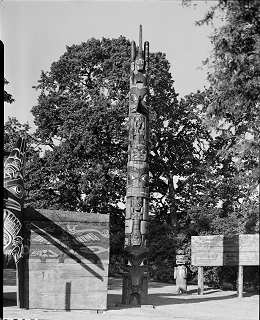
In Thunderbird Park in 1952 the Haida memorial pole, with new paint, was surrounded by a random placement of Nuxalk and Nuu-chah-nulth monumental works: a house entrance pole from Talyu with a painted screen from Ahousaht on the left, a mortuary figure from Talyu and a Huu-ay-aht painted screen on the right. I-29807.
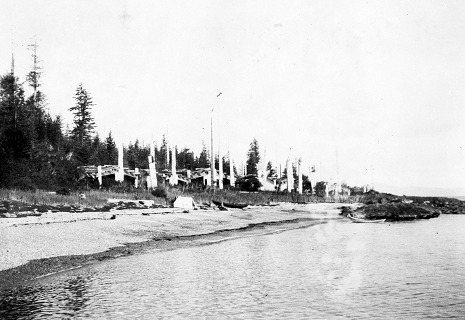
By the time this panoramic view of T'anuu Llnagaay was taken in 1901, its inhabitants had moved away to other villages such as Skidegate and Masset. But the village was not abandoned. People from T'anuu Llnagaay maintained their connections to the place, as do their descendants today. D-00549.
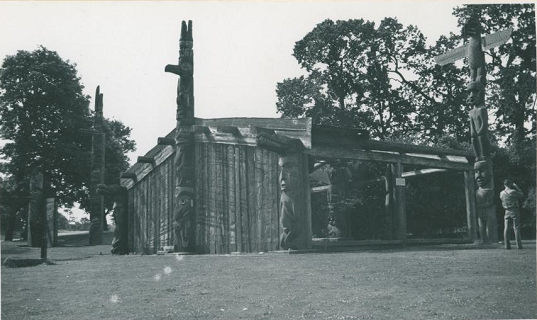
When Thunderbird Park was established in 1941, the memorial pole from T'anuu Llnagaay was erected in front an open-sided structure meant to evoke a Haida house. But although the Sea Lion beams at the corners of the roof came from a house on Haida Gwaii, the poles supporting them are Nuu-chah-nulth and the painting on the house front is an approximation of a Northwest Coast design by a non-Indigenous artist. T. W. S. Parsons photograph. PN 6021.
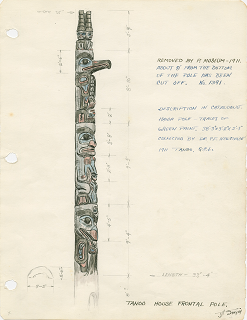
John Smyly’s drawing of the original pole from T'anuu Llnagaay, which Charles F. Newcombe collected in 1911.
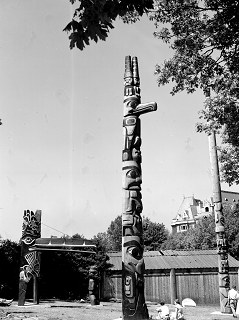
The replica (RBCM 20128) carved by Mungo Martin, David Martin, and Henry Hunt was installed in Thunderbird Park in 1954. I-26972.
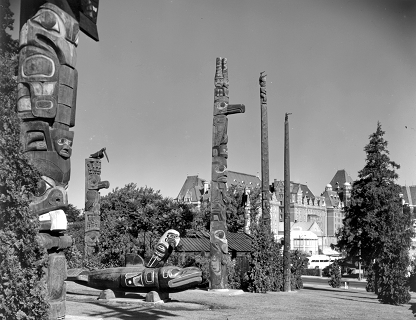
A view of Thunderbird Park with the replica pole (RBCM 20128) in the centre, 1967. I-21012.
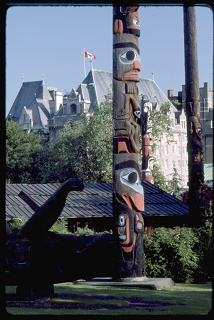
The replica pole (RBCM 20128) in Thunderbird Park, 1984. I-04502.

The replica pole (RBCM 20128) in Thunderbird Park, 2018.
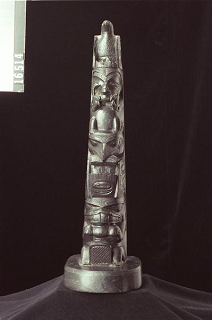
Jiilakuns is a frequent Haida subject. On this undated argillite pole by an early 20th century Haida carver, she is shown with a frog emerging from each eye. The other figures are an eagle-like bird with a fish in its talons, Raven holding a net full of fish, and Beaver. RBCM 16514.
Charles F. Newcombe typically recorded more information than many collectors at the time, but here his notes are unclear. He wrote that the pole had been raised by a man called Checkgath (Tsiikgahl) around 1880 as a memorial to his wife, but also that it was raised by a man named Teihial with help from his nephew, Naikikles (Neekekyals).
The figures depict some of the owner’s crests. At the top are three Watchmen, guardians who look out to sea and are said to call out warnings at the approach of enemy canoes. Their hats have rings called skils, which show their high status. Newcombe called the bird below a thunderbird, but it has also been described as Eagle and as Cormorant, which is an Eagle clan crest. Newcombe said the human-like figure holding a frog was a doctor or shaman, but it likely represents the powerful Eagle clan ancestress, Jiilakuns, known as Frog Woman, Copper Woman and Volcano Woman. Whale with an upside-down human face in its blowhole is at the bottom of the pole.
There are many stories about Jiilakuns. In one, five young men paddled from their village to fish in a nearby stream. While they were roasting fish over a fire, four frogs appeared, one by one, and the young men threw each of them into the fire. Then a woman appeared in the distance, wearing a large labret (lip plug) and carrying a cane with a carving of a frog at the top. She cried continually for her lost children. As the fishermen fled in their canoe, the woman caused them to die, one by one. Then she caused their village and its inhabitants to be destroyed by fire because the young men had killed her children, the frogs.
The pole from T’anuu Llnagaay was erected in Thunderbird Park. When a replica was made in the Thunderbird Park Carving Program by Mungo Martin, his son, David Martin, and Henry Hunt in 1954 (RBCM 20128), the original pole was moved inside. It now stands in the museum’s glass lobby.
Do you have a story to share about this item? Add your voice to the community.